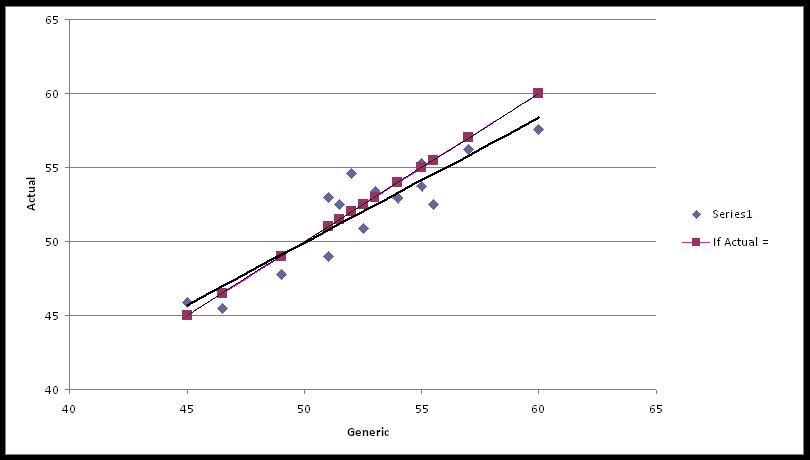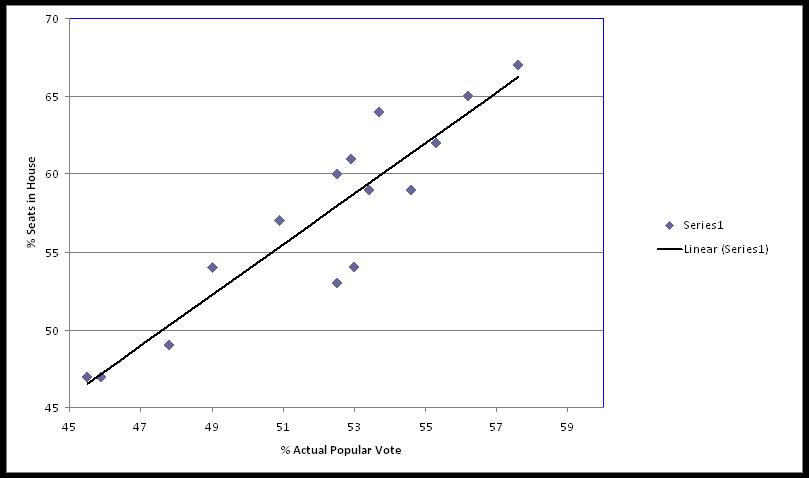Two weeks ago Democrats’ hopes for the midterm elections were briefly raised when the Gallup generic ballot came back showing a dead heat, 46%-46%, in voters’ preferences between the two parties. Some progressive media sites, buoyed by the poll, wondered why it did not receive more press coverage. Alas for Democrats, the most recent Gallup survey puts Republicans back up by 5%, 48%-43%, a margin that is identical to the average lead held by Republicans in the Gallup poll since the start of August. I’ve written before about the need to view one-time fluctuations in the generic ballot results with caution, and the latest results are a reminder that, despite these fluctuations, for the most part Republicans have lead in the generic ballot for almost two months. This is important, because as I’ve also discussed in previous posts, the generic ballot results are a useful, if not infallible, tool for predicting the actual midterm results. As I noted in my previous post, several of the midterm forecast models developed by political scientists incorporate the generic results, and these are the ones that suggest Republicans are poised to gain upwards of 50 seats in the House come November.
To get a sense of the significance of the generic ballot, I had my research assistant Matt D’Auria plot the final Gallup generic ballots results (the x-axis) against the actual aggregate popular vote (the y-axis) received by the Democrat Party in each midterm election dating back to 1952. For comparison purposes, he also plotted the results as if the generic result perfectly predicted the actual aggregate support for the Democrats (the red line).
By fitting a regression line to the actual data, we can construct a simple equation that estimates the final popular Democrat vote based on the generic ballot results. If we plug in 43%, which is what Democrats are currently receiving on average in the generic survey, the regression suggests that Democrats will receive 44% of the actual aggregate popular vote in November. That’s actually better than one might expect, given that in most years the actual vote falls below the generic results. (Warning: this is a crude estimate, particularly since the current level of Democrat support is lower than that in any of the previous years’ totals included in our sample.)
However, what we really want to know is how many seats the Democrats are likely to win, assuming – as our crude model does – that they receive 44% of the aggregate popular vote. If we plot previous aggregate support against actual seats won, we can again estimate a very simple regression equation, keeping in mind all the caveats mentioned above.
Plugging in our predicted value of 44% popular support for Democrats, our crude model indicates that Democrats will win about 44% of the 435 House seats, or only 191 seats come November – a projected loss of 65 seats!
Now before my Democrat readers slit their tree-hugging wrists, keep in mind that these are very squishy estimates; there’s a large margin of error around this projection. None of the more sophisticated forecast models of which I am aware forecast Democrats losing 65 seats. And with a month and half to go before the midterms, the generic ballots results can still change. Moreover, the simple model I’ve presented here encompasses a long time period during which the underlying dynamics of congressional elections has evolved. However, these long-term changes don’t necessarily help Democrats. Most importantly, as I’ve indicated in previous posts, congressional elections – including midterms – have been increasingly nationalized in recent years. That is, individual races are more susceptible to broader forces affecting the nation as a whole. And right now, those broader forces – most notably the lagging economy and ambivalence toward the Obama presidency – are working against Democrats.
This is all a long way of saying that the recent Delaware Senate primary results are, in my view, consistent with a broader picture, one that does not bode well for Democrats in the coming midterm elections. They may not lose 65 seats, but if history repeats, they are likely to lose closer to 40, and their majority, than to 25 which is the post-World War II average.
Is there any way to prevent his from happening? If I am an individual Democrat in the House from a marginal district (one in which I won with less than 55% of the popular vote) and am running for reelection in this climate, I would fall back on those tactics that traditionally work for incumbents: emphasizing constituency service and name recognition, reminding voters about what Republicans stand for, and distancing myself from the President and his policies. The goal is to make this election a choice – not a referendum on the party in power.




